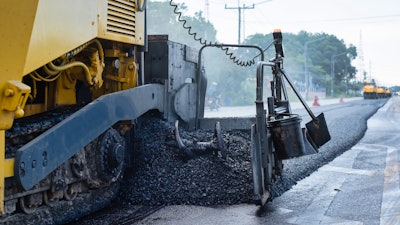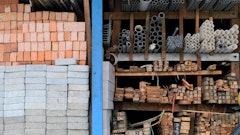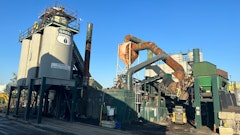
Certain aspects of quality control testing hasn't changed all that much over the decades. While it is necessary and extremely important, when working with various Departments of Transportation (DOT) and, potentially, individual districts within a state, parts of the process might be overdue for an overhaul. When dealing with government bureaucracy, however, bringing about change is a lot easier said than done.
In most states, the DOT creates a document called the Schedule of Material Control which dictates the testing frequency (the number of tests), as well as the types of tests that must be conducted. In addition to that, there are also some state DOTs that work with the industry to create test summary sheets. These are basically a large table or spreadsheet that lists the asphalt and aggregate, requirements, or specifications on the left side. To the right are columns that describe a given test's results.
"Those columns categorize the date, test number, sample time, number of tons represented, mix price, mix design report number, project number, asphalt cement grade, aggregate products, aggregate sources, proportions, and QC actions, etc." said Rob Kuehborn, Director of Materials and Quality at Central specialties incorporated in Alexandria, Minnesota. He, also, sits on the Board of Directors for the National Asphalt Pavement Association (NAPA). "There's a lot of information on the test summary sheet. It is essentially a status report of how a given mix is complying, or not, with the properties it has to meet at a given point of production."Kuehborn speaks from more than three decades of experience working in the industry, and, specifically, when it comes to the process by which these tests are conducted. From his perspective, it is time to update the status quo, and ditch one method of sample obtaining once and for all.
Tools of the Trade
The purpose of these quality control measures is to ensure the product stays within the compliance tolerances of the given specification. While most DOTs will create the worksheet templates and spreadsheets, the physical testing is mostly done by hand in an asphalt mixture labratory.
“Generally speakiong, sampling isn't extremely sophisticated. Samples are usually collected with shovels and buckets," said Kuebhorn. "There are some more mechanically automated processes available for permanent plants, but they are generally not the norm, yet. Correct sampling methods are critical. Getting a homogenous and representative sample can make or break the test results."
When it comes down to it, there are two primary locations where asphalt mix samples are obtained. The first is at the source itself, the asphalt plant where it's produced. The other place where sampling occurs, and the one which many DOTs historically prefer, is right at the paver at the exact location where the asphalt mat is constructed or, sometimes, a sample is taken in front of the paver from the windrow, before it's put into the hopper and through the paver itself.
Kuehborn argues the industry would be better off discontinuing sample collecting at the paving site.
Safety Concerns
Worker safety is always the primary concern when it comes to anything taking place in an active jobsite. Road construction can be particularly harrowing, and national statistics reveal that work zone related injuries, usually involving distracted drivers, an already an unacceptable danger, and it’s on the rise.
"It's extremely dangerous for technicians to go out on the road, often at night, in active construction, when they are between various pieces of the paving train that they are not normally part of,” Kuehborn said. “Also, they may not be seen by incoming and exiting haul trucks, which can be a particular hazard. Even just parking in an active construction zone in relatively small pick-up trucks has risks.”
Compare those risks to the relatively low-level risks involved with taking samples right at the point of production, the plant site. It certainly seems there's a solid argument to be made to eliminate the chance of quality control engineers and technicians coming into harms way unnecessarily. With that in mind, why do some DOTs still require sampling be done at the construction site?
According to Kuehborn, it might be rooted in a past history of distrust between DOTs and the industry. "There's some agencies that still want their sample from the roadway, and unless they see it taken from it, they can be skeptical," he said. The questions remains: couldn't the DOT send its inspectors to the plants, and watch the samples being safely taken from a truck headed to the correct project site?
The truth is that it is different in every state's districts. Some have enough of what they call "plant monitors" to visually oversee the technicians doing their job which includes obtaining the samples. In a perfect world, this would be the majority of cases. In reality, however, there often aren't enough DOT plant monitors to witness sampling at various plants within a given district, thus the requirement to get samples from the road and the hazards that come with it. Ultimately, though, sticking to this method isn't just less safe. It could also be seen as having a negative impact on the asphalt mix quality itself.
Delayed Quality Control Actions: Time is Quality is Money
Obviously, to sample from behind the paver, putting a technician in a dangerous environment is one thing, and is a reason to reconsider this practice. But another significant drawback from this method is the delay between sampling and the testing itself. It's not unusual for a sample to be collected and then followed by a forty-five minute drive back to the plant/labratory location. Depending on congested traffic and distances, that delay could easily stretch to an hour or beyond. That on top of the hour it typically takes to get lab results. Then, once it arrives, what if the test results reveal a problem that needs to be adjusted and corrected? Kuehborn's perspective is tough to debate here.
"You've just wasted a whole lot of time which equals a whole lot of production," he said. "If the mix was tested at the plant, you would know generally within an hour. Instead, you've lost an additional hour in an industry where you are producing anywhere from two to eight hundred tons per hour. That's a lot of material, money, and quality at stake.”
For contractors, however, it's not just time and material that are factors here, it's also about the revenue on these projects. Many states utilize what are called "pay factors" where various quality indicators determine the contractor's percent of unit price paid. These might include, but aren't limited to: gradation, air void content, asphalt binder content, voids in mineral aggregate, adjusted film thickness (thickness of the AC coating on each particle),coarse and fine aggregate angularity, smoothness, density, etc.
“DOTs normally have Schedules of Mixture Adjustment Costs,” he said. “These schedules outline whether the unit cost of the mixture will be paid for with incentive (bonus), 100 percent (bid price), or disincentive (penalty). They often apply to many of these quality indicators. Achieving a certain level of compliance or non-compliance will dictate the level of price paid to the contractor. If the extent of non-compliance is severe enough, it can result in removal and replacement.”
"It's a balancing act," Kuehborn continued. "In a way, it's like walking a tightrope. The various mix characteristics, smoothness, and desnity are all the basis of payment. They all have to be in line at the same time, and if they're not, you have to figure out how to get that one quality component back in-line without throwing the other ones out."
It makes sense that those working to achieve that balancing act would prefer to have more timely data, and be able to respond quicker before more out-of-spec material potentially leaves the plant.
"Faster realized test results are definitely in the best interests of the buyer, the seller, and, ultimately, the tax payer," he said.
Doing More Harm Than Good
Major worker risk is enough reason to stop sampling at the paver site, but beyond safety, the delay in material adjustment response time, and the potential loss of payment, behind the paver sampling can also directly damage the new pavement itself. This puts it in direct opposition to the purpose of quality control testing. If the goal is to ensure consistent, on-spec, high quality, and long lasting pavements -- then broader implementation of plant sample procurement should be the way forward.
"Anytime you disturb the mat you're creating inconsistencies," said Kuehborn emphatically, who became quite passionate during this portion of the discussion. "Whether you take a two-by-two or a four-by-four square foot sample behind the paver, you've disturbed the integrity, density, and smoothness of what was laid down. Really, it could well be the first stage of a future pothole.”
Some people sample better than others, but you can never truly get the sample location in the same condition as that which was originally placed by the paver. You’ve dehomogenized the mix that was there and left it in a less dense state. Thus, the rollers are unlikely to get the same density there as the rest of the mat. You may also create a bump. These are things that a lot of agencies don't seemingly want to acknowledge.
Rob Kuehborn contributed greatly to the contents of this article beyond the inclusion of his quotes.




















